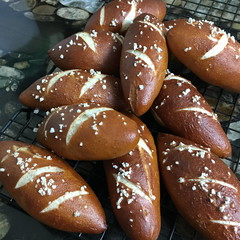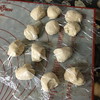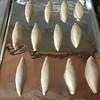 Pretzel Rolls, really. Cute, little pretzel rolls, about 4 inches long, a good size for nibbling. The goal of this Bread Bible recipe is the authentic soft-pretzel taste and appearance, though not the shape.
Pretzel Rolls, really. Cute, little pretzel rolls, about 4 inches long, a good size for nibbling. The goal of this Bread Bible recipe is the authentic soft-pretzel taste and appearance, though not the shape.This is a fairly small dough recipe, maybe because the edible half-life of an uneaten soft pretzel is quite short. The recipe uses bread flour with a few tablespoons of whole wheat thrown in as many of The Bread Bible recipes do. I did add the optional malt powder--diastolic, as it turns out, as the recipe didn't specify and that's what was open. (I now have found Rose's note in the back saying that she uses non-diastolic because her flour is malted...oh well. At this amount, I don't think it matters much.)
The dough mixture was quite dry, so I added a teaspoon or so of water early in the kneading to get everything moist. Then after a generous 7 minutes of kneading, I had several pieces of very stiff dough--it had been one ball for a while, but then separated and wasn't moist enough to come back together. At that point I added another half-teaspoon of water and gave it another 3 or 4 minutes of kneading. I wouldn't call the result a smooth ball of dough, but at least it was one piece. Also still very stiff, as the recipe indicated it would be.
 I divided my ball of dough into 12 pieces of 33 grams each, which was much smaller than the size the recipe indicated of 3.5 inches by 2.5 inches high. These were to be shaped into flattened balls for the first rest and rise. Mine ended up as flattened dough circles of about 2.5 inches diameter, and maybe 1/3 inch high. I see from notes in the bake-along Facebook group that the size guidelines seem to have been dropped from a later edition of the book, perhaps to correct this. I'm beginning to think I should sell my copy and buy a new one (probably an ebook, at this point, as I think I've got plenty of general bread books around now)--the revisions between the editions clearly go beyond the errata that I've already marked in my copy.
I divided my ball of dough into 12 pieces of 33 grams each, which was much smaller than the size the recipe indicated of 3.5 inches by 2.5 inches high. These were to be shaped into flattened balls for the first rest and rise. Mine ended up as flattened dough circles of about 2.5 inches diameter, and maybe 1/3 inch high. I see from notes in the bake-along Facebook group that the size guidelines seem to have been dropped from a later edition of the book, perhaps to correct this. I'm beginning to think I should sell my copy and buy a new one (probably an ebook, at this point, as I think I've got plenty of general bread books around now)--the revisions between the editions clearly go beyond the errata that I've already marked in my copy.
 After the first rise, the dough pieces of whatever shape get formed into vaguely football (American, that is) shapes and get a second brief rise, then are refrigerated to firm them up for the dipping-in-lye process that produces the classic pretzel crust. I did procure food-grade lye and very cautiously used it for my dipping solution, and indeed got the pretzel-brown finish I wanted. In one change from the recipe, I dipped my rolls first, then slashed them, so I would get the color contrast on the finished rolls.
After the first rise, the dough pieces of whatever shape get formed into vaguely football (American, that is) shapes and get a second brief rise, then are refrigerated to firm them up for the dipping-in-lye process that produces the classic pretzel crust. I did procure food-grade lye and very cautiously used it for my dipping solution, and indeed got the pretzel-brown finish I wanted. In one change from the recipe, I dipped my rolls first, then slashed them, so I would get the color contrast on the finished rolls.
 Results: the appearance was great--very pretzel-ly. I'm not a huge soft pretzel fan so my personal tasting comment is "it's a soft pretzel", and all other tasters got these the next day when the salt had melted with storage and the rolls were beginning to stale. Didn't stop them from getting eaten, though!
Results: the appearance was great--very pretzel-ly. I'm not a huge soft pretzel fan so my personal tasting comment is "it's a soft pretzel", and all other tasters got these the next day when the salt had melted with storage and the rolls were beginning to stale. Didn't stop them from getting eaten, though!
They look perfect! This past month was a real killer. I'm going to tackle the pretzel bread and fig bread this week so I'm glad for your corrections since we both have the same crazy books Funny how such a small ingredient/direction difference could interfere with the outcome, but not so funny when all the time and effort are put into it.
ReplyDeleteNancy, your pretzels look great! I really enjoyed baking these. I also got contrast even though I slashed before dipping ...i think for the same reason the slashes don't brown when baking any other bread?
ReplyDeleteThese turned out so well for you Nancy. I laughed at your half-life comment. I think half-life could also be related to how delicious a baked good is.
ReplyDeleteabsolutely gorgeous!
ReplyDelete